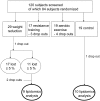Triacylglycerol fatty acid composition in diet-induced weight loss in subjects with abnormal glucose metabolism--the GENOBIN study
- PMID: 18612464
- PMCID: PMC2440352
- DOI: 10.1371/journal.pone.0002630
Triacylglycerol fatty acid composition in diet-induced weight loss in subjects with abnormal glucose metabolism--the GENOBIN study
Abstract
Background: The effect of weight loss on different plasma lipid subclasses at the molecular level is unknown. The aim of this study was to examine whether a diet-induced weight reduction result in changes in the extended plasma lipid profiles (lipidome) in subjects with features of metabolic syndrome in a 33-week intervention.
Methodology/principal findings: Plasma samples of 9 subjects in the weight reduction group and 10 subjects in the control group were analyzed using mass spectrometry based lipidomic and fatty acid analyses. Body weight decreased in the weight reduction group by 7.8+/-2.9% (p<0.01). Most of the serum triacylglycerols and phosphatidylcholines were reduced. The decrease in triacylglycerols affected predominantly the saturated short chain fatty acids. This decrease of saturated short chain fatty acid containing triacylglycerols correlated with the increase of insulin sensitivity. However, levels of several longer chain fatty acids, including arachidonic and docosahexanoic acid, were not affected by weight loss. Levels of other lipids known to be associated with obesity such as sphingolipids and lysophosphatidylcholines were not altered by weight reduction.
Conclusions/significance: Diet-induced weight loss caused significant changes in global lipid profiles in subjects with abnormal glucose metabolism. The observed changes may affect insulin sensitivity and glucose metabolism in these subjects.
Trial registration: ClinicalTrials.gov NCT00621205.
Conflict of interest statement
Figures






References
-
- Moller DE, Kaufman KD. Metabolic syndrome: a clinical and molecular perspective. Annu Rev Med. 2005;56:45–62. - PubMed
-
- Yu-Poth S, Zhao G, T E, Naglak M, Jonnalagadda S, et al. Effects of the National Cholesterol Education Program's Step I and Step II dietary intervention programs on cardiovascular disease risk factors: a meta-analysis. Am J Clin Nutr. 1999;69:632–646. - PubMed
-
- Stefanick ML, Mackey S, Sheehan M, Ellswotrh N, Haskell WL, et al. Effects of diet and exercise in men and postmenopausal women with low levels of HDL cholesterol and high levels of LDL cholesterol. N Engl J Med. 1998;339:12–20. - PubMed
-
- Metz JA, Stern JS, Kris-Etherton P, Reusser ME, Morris CD, et al. A randomized trial of improved weight loss with a prepared meal plan in overweight and obese patients: impact on cardiovascular risk reduction. Arch Intern Med. 2000;160:2150–2158. - PubMed
-
- Lelliott C, Vidal-Puig AJ. Lipotoxicity, an imbalance between lipogenesis de novo and fatty acid oxidation. Int J Obes relat Metab Disord. 2005;28(Suppl. 4):S22–S28. - PubMed

